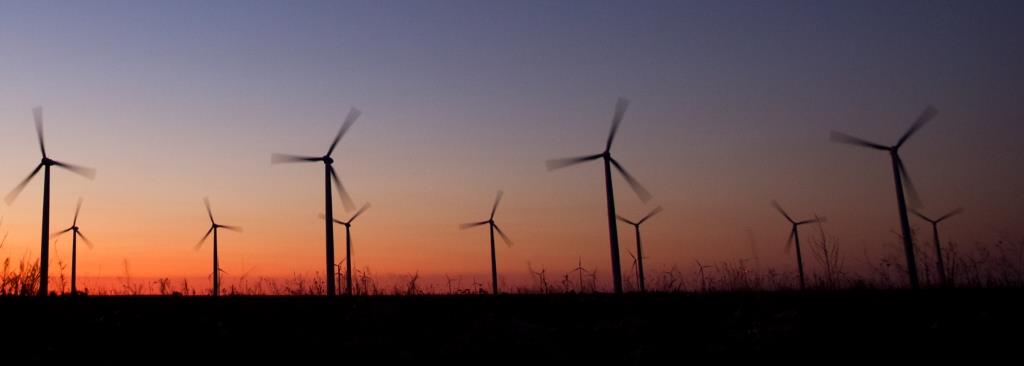
UK Onshore Wind Turbines
In this weeks blog we are going to look at the advantages of onshore wind turbines. In the UK, wind energy plays a significant role in our energy mix, providing enough electricity to power 4.5m homes in total.
Onshore wind has an installed capacity of 5,619MW, roughly twice that of offshore wind, and produces about 13,000GWh of electricity, enough to power about 3m homes per year.
There has been lots of press attention recently over the role of wind turbines in our energy mix, so we are going to weigh up what we see as the potential advantages and disadvantages of this form of renewable technology.
Advantages of Onshore Wind Turbines
It is a proven Technology
It is already helping provide a significant amount of electricity to the grid. In 2010, onshore electricity provided about 7TWh of electricity to the grid, approximately 25% of the renewable energy in the energy mix in the UK.
It is thought that this might be as high as 30TWh by 2020.
It is comparatively Cheap
Onshore Winds primary advantage is that it is the cheapest renewable energy source currently available to the UK, working out at about 8p / kWh. This puts it slightly more expensive that gas and the other more established fossil fuels which come in about 4-7p / kWh, but is substantially lower than situating the turbines out at sea.
It is quick to install
While a nuclear power station might take in excess of 20 years to construct from the initial planning permission phase, a wind turbine can go up and start providing electricity to the grid in a matter of months.
Limitations of Onshore Wind Turbines
Not 100% Green
So are wind turbines completely green? Well no, despite producing emission free electricity when in operation, they are limited emissions associated with their manufacture and installation.
Noise Pollution
Some people who live in close proximity of the wind turbines complain of the noise they make when the wind is blowing. The infographic from GE demonstrates how loud wind turbines actually are.
Eye-sore
Onshore wind turbines are often criticised for their visual impact, ruining what previously have been areas of natural beauty. They are typically spread out over larger areas than other energy producing installations, and therefore have a larger impact on the local environment.
They don’t produce electricity 24/7
The other major issue with any type of wind turbine is that it produces electricity intermittently. This wouldn’t necessarily be an issue if we could store the electricity produced when demand is very low, but energy storage is currently very inefficient, expensive and unproven.
The Future for Wind Turbines
If the cost of manufacturing wind turbines falls, then very quickly the cost per kWh of electricity produced from wind will reach parity with electricity made from burning fossil fuels.
Potentially, as the wind industry continues to grow, economies of scale can be introduced (ability to make something cheaper, the more you make of it) and the technology will become more efficient (for example, nanotechnology allowing the blades to capture more of the kinetic energy in the wind) so the price to produce the electricity from wind turbines will continue to fall.
There are initiative solutions to make renewables produce power 24/7 currently in development. The Crescent Dunes Solar power plant takes advantage of molten salt technology to keep electricity flowing while the sun doesn’t shine.
In theory, Wind Turbines could be coupled with pumped storage such as the Dinorwig power station in Wales, but even that storage mechanism is limited, and requires a lot more energy to create the electrical potential energy, than can be used for useful work.
Have a look at our energy storage section to see other potential solutions that make make 24/7 production viable.
The last point here, and the one that I think is most important, is that as people begin to grow up with wind turbines around them, they will become the norm and therefore more accepted. Currently many of the people complaining about them have seen these things installed in the last 5 years or so, so knew what the land was like before they were there.
Children growing up now will know no different, the wind turbines will simply be ‘part of the furniture’ and therefore they will recognise them as what they are, simply smaller scale energy power plants.
References
https://www.gereports.com/how-loud-is-a-wind-turbine/














I’m pro wind power but your article is very disingenuous regarding noise. Decibels are not really a good measure of noise pollution as anyone with some acoustic wherewithal will know. The frequency and pattern is probably more important and less easy to measure.
A turbine will sound different depending on the conditions and context – it certainly won’t sound like a fridge or an AC unit. The only way to know how annoying they are would be to live near one for a month or two – or listen to those people who do live near them.
They are ugly, unless you are a victim of brainwashing.
They kill endangered species, birds, eagles, owls and other birds.
They are inefficient for the amount of space used.
The biggest disadvantage is they are brainwashed into people brains because they don’t understand electricity. If you want to stop using wasted power, then use solar panels on your house and reduce the load using DC lighting and DC equipment and go OFF grid and tell the rich elite plutocrats who sell this crap to ignorant lemmings to go sell their electricity to some other stupid person who knows nothing about science.
You are right james
thank you James I thought I would get brainwashed for a second!
James, not everyone wants to see this massive propeller thing sticking out of their garden. I would suggest you coming to my house near Leicester and would be happy to show you the environmental pollution these things are causing.
Hi James – thanks for the comment. While I agree they are not everyones cup of tea, I don’t think they are quite as bad as you are making out! I think the major problem is that in the UK we need to increase our energy independence – i.e. be less reliant on other countries for gas and oil. Wind turbines do just that, but I guess the major problem with them and many other renewables is that they are intermittent, meaning they only produce electricity at certain times.
It seems then, that the big issue is energy storage – to better meet supply and demand, but storage technology seems to be playing catchup – while there are some interesting ideas out there, they all seem to be in the R&D stage at the moment so it will be interesting how this area develops in the coming years.
Hi Alexander. thanks for commenting and point taken. But surely if you look at the paragraph in the article you will see we have appreciated the fact that a “noise” can be a problem rather than dismissing it altogether. I would also say that all forms of energy generation have their pitfalls, but if we are against every form of new generation due to a particular flaw then are we not giving ourselves a bigger headache in the ability to keep lights on going forward?
i think that overall this artice is brilliant it goes into detail about the pros and cons of onshore wind turbines is covers all aspects of it and even goes into depth about the noise pollution uses statistics about how far away you can be without hearing the turbine. i agree with it being relatively quick and cheap to install because they are not dependant on weather for example like the off shore turbines where they cant install them if the sea level is about 1.4 meters or if the sea is too rough
Beauty is in the eye of the beholder James Arjuna and it is ridiculous to think that someone who disagrees with your version of beauty is brainwashed. How are they inefficient for the space they take up? The land can still be farmed or used for pasture. You can’t farm in a power station. Wind power in association with solar is the quickest and best way to reduce CO2 emissions.
no
Some of the pro comments on here. The technology is hideous!
this is not helpful please delete this and jump off cleddau bridge cause this has been a waste of my time
love kim joung yn